Box Calls – from these instruments come the sounds that turn on the lights for turkey hunters, sounds that put a smile on our face and brighten an otherwise level moment of life into one of pulse-quickening excitement and memories.
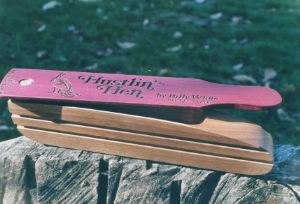
Hustlin’ Hen Box Call by White Hunter Game Calls
The purpose of this series is to discuss the various types of box calls and describe a sampling of techniques in using each call. There are some solid basics to running a turkey call. Often referred to as the ‘proper’ technique. I like to think of these basics as a foundation on which each of us develops his or her personal style of calling. Who wants to sound exactly like every other hunter in the woods? The old boss will wise up to that quick. Rather, it is better for each caller to put his individual style into the sequence and tempo of the sounds he is making. The goal of better calling is to make us more successful turkey hunters. Experiment from a foundation of basic techniques; try your style out on the birds and when it consistently produces results – lock in!
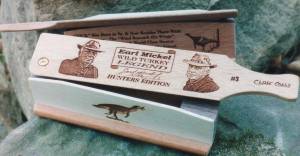
Close Calls-Earl Mickel Wild Turkey Legend Box Call
The information provided, does not come from experience as a contest caller or from being the most successful hunter in the woods. These ideas and insights are reflections from conversations and meetings with call makers and Midwest customers over the past twenty years. It is a pleasure to pass on information that has been shared with us. But if you ask where that double-bearded, 24 pound boss roosted last night, well, it was surely the other side of the county.
Section One: Two-Sided Box Calls
Considered by many to be the king of turkey calls, the box call boasts a list of strong qualities to justify the title: easy to use, dependable in operation, handsome in appearance, historically significant, and very effective in calling turkeys. Maybe this is why the box is the most widely collected of turkey calls.
An inexpensive production box can be a great turkey caller. As craftsmanship and ornamentation increase, so does the price. Handwork and hand tuning of these finer quality box calls takes time. Many are considered to be fine art. As in any trade, better work brings greater compensation. You may ask, “Is it worth it to buy an expensive box call?” That is a personal decision. But if pride in ownership, uniqueness of sound, or a diverse collection of calls is important to you, I would say yes, it is certainly worth it.
Besides craftsmanship, other factors contribute to the sound of a box. Type of wood used has a distinct effect. For instance, poplar sided calls generally make a fuller ‘yawping’ yelp, mahogany or walnut sides give a higher pitched raspy tone and cedar sides are unequaled for purring. The size, shape and box design also effect sound.
A frequent but not defining feature of two-sided box calls is the ability to make the sound of two different hens, one from the right blade and a different pitch or rasp from the left blade. Some callers and collectors will seek out a box with ‘two hens’ in it. Others prefer the same, similar tone from each side of the box.
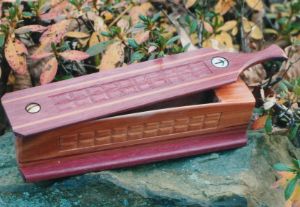
Dad’s Cedar & Purpleheart Box Call
The operation of the box call is quite simple in its basic form. Hold the box in front of you with your forearms at your side. Wrist action from the hand that holds the paddle is the only necessary movement. Based on right-handed usage, the paddle handle will be loosely held in the fingers of the right hand, the box held gently in the left. Gripping the box or the paddle too tightly decreases the sound resonance ability of the call and generally sounds bad. The paddle can be held with thumb on top and index finger beneath or between index and forefinger perpendicular to the flat paddle.
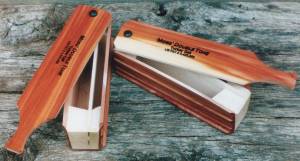
Moss’ Double Tone Turkey Call
For the yelp, move the paddle only one inch or so to the right of the right blade. Drag the lid across using light downward pressure until the high beginning note breaks off to the lower tone end of the yelp. Now drag the paddle back across the right blade, without lifting the lid off of the blade, (the box is designed to not make any sound on this backward drag to enable the caller to keep the two surfaces in constant contact.) Now start the process again. A series of 2 – 6 yelps is most common in spring calling.
The cluck on the box call is accomplished in several ways: Hold the paddle in contact with the right blade, about one inch out from center. Use downward pressure from the thumb, on top the lid handle (index finger beneath) and ‘pop’ the paddle 1/8 to ¼ “ to the left. This method takes the least movement. Or, open the box slightly, paddle to the right and place the thumb of your left hand gently on top the paddle (while holding the box in the left hand). Use downward pressure with the left thumb onto the paddle top; tap the paddle handle from the right with the combined index and forefingers. You may have to practice this technique a bit, but it produces excellent popping clucks. With a little more pressure, these clucks can be turned into cutts for more aggressive calling. Add speed to the increased pressure and a good fly down cackle is made. Using the next technique, clucks and the louder cutts may be made by opening the paddle about 2 “ to the right of right blade, lifting the paddle and sharply tapping it against the right blade at a slight downward angle from right to left. Softer taps yield clucks. Harder and more rapid taps make the more demanding cutting sounds of the hen turkey.
Purring is often done with other types of turkey calls (slate calls, push buttons or diaphragms), but decent purrs can be made with the box, especially one made of Eastern Red Cedar. To purr on a box, hold the call as you would for yelping. Bring the lid out about 1”, making contact with the right blade. Exert some downward pressure on the lid handle, pushing it to the left slowly. It only takes ¼”-1/2” of movement to produce purrs. Experiment with the pressure. Additional leverage for this deliberate stroke can be gained by placing the right forefinger into the rear side base of the box, while pushing the lid left with thumb and index finger.
Some boxes are designed and tuned to produce a different sound on each side. The above techniques also work off the left blade. It is easier to run the left blade if the box call is held vertically with the screw end tipped slightly forward. The caller will move the lid across the left blade in a direction away from his body.
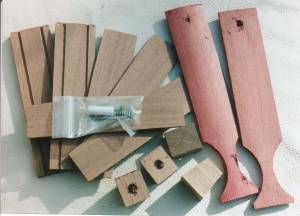
Pine Ridge Purpleheart & Walnut Box Call Kit
These techniques are basic information. There are several other ways to hold and use a box call. The two most common are: 1. Paddle up – Hold the box base in the left hand vertically in front of the chest. Paddle handle is pointed upward and held between index finger and forefinger. Paddle handle is brought slightly toward the caller, than stroked forward across the blade of the box. 2. Box as striker – Again box is held upright with screw end down. This time paddle and paddle handle are positioned in left hand. Paddle top rests against palm of left hand and handle is held between index and forefinger. Base of box (at screw end) is held in right hand with sharp forward motions creating the sound. This style is mostly used for aggressive cutting and yelping in an effort to locate and fire-up a gobbler.
The preceding text is the sole thoughts and opinion of George Lozzi, Turkey call enthusiast and owner of MIDWEST Turkey Call Supply. For reprint or copy permission, please contact George at CustomerService@midwestturkeycall.com or call 573-824-5303. © 2005
